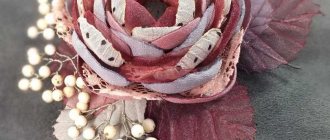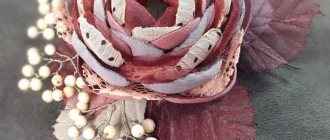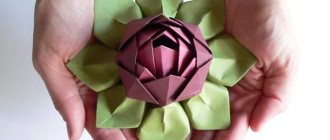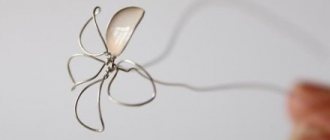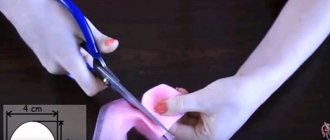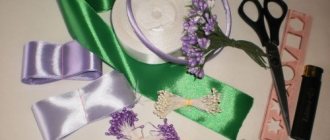Crafts from nylon tights
Every woman's wardrobe has nylon tights of different colors, densities, and sizes. But they have a common problem - they break very quickly. As soon as the slightest clue appears, the tights are off. You have to throw out the old ones and buy new ones.
But what if we look at the situation differently? It’s very easy to make amazing flowers from old nylon. Instead of spending the whole evening in front of the TV or computer, you can get down to business and turn an old unnecessary thing into a masterpiece.
Technique for creating a flower
It is easy to collect nylon flowers - for this purpose, the frame of each petal is made of wire,
and only then it is covered with nylon fabric. It is for this work that you need to prepare templates. At the base, the ends are fixed with threads, everything is collected into a single inflorescence and secured on a wire stem or on a wooden skewer. Sloppy edges of the fabric are covered with a strip of tape or covered with corrugated paper. Finished flowers and leaves are assembled into a beautiful composition
What materials are needed for making flowers yourself?
One nylon for making decorative flowers, of course, is not enough. You will also need wire, templates, cotton wool, napkins, tape.
of wire : rigid and flexible. One for making stems, the other for petals. Rigid wire will be needed to make the stems. Blanks for petals are made from flexible wire. The maximum length of the roll is eighty centimeters, but, if necessary, you can purchase a smaller roll. The wire is usually coated with plastic, but paper coating may also occur.
If for stems, usually use green and brown wire. It is worth purchasing flexible wire in different colors so that you can make white, red, blue and other products from it.
Materials you will need
To make jewelry from nylon, there are special devices, textiles, as well as ready-made decorative elements. All this can be purchased at craft stores.
Composition of nylon flowers as home interior decoration
Thanks to the rich variety of handicraft products, few people in modern realities make flowers from nylon tights. This method has several disadvantages: insufficient strength and elasticity of the fabric, a small variety of colors and textures, as well as size: the resulting cuts from tights do not always allow you to complete the composition.
Capron
The main material for floral decoration is nylon fabric. This material is created in textile factories specifically for this type of needlework. During its production, the tension of the nylon on the frame and the bending of the products are taken into account, so the nylon fabric is strong and durable, but at the same time it is thin and transparent. Nylon is produced in several versions (plain, multi-colored, openwork, with glitter, etc.).
As a rule, nylon flowers are created from standard size textile fabrics, but when creating large floral decorations it is possible to use giant nylon.
Floral nylon
Note! The special nylon for creativity stretches well. This avoids deformation of the petals when it is pulled onto the frame.
Wire
The basis of the product is a special pliable wire. Thanks to it, the structure is stable and durable, and at the same time, the frame of the product is quite flexible - this allows you to give the desired shape to the entire composition.
What kind of wire is needed for nylon flowers and stems - its thickness, stiffness and texture - depends on what it will be used for. When creating petals, flexible and thin wire is used, and for stems, hard and thick wire is used. A variety of wire surfaces (fluffy, paper-braided or lint-free) will allow you to achieve the desired effect without much difficulty.
Floral wire
Special devices and tools
To work, you need to prepare tools that will help make the creative process easier and more enjoyable:
- Scissors. Sharp manicure scissors are ideal for working with nylon.
- Pliers or wire cutters. Necessary for cutting and bending wire.
- Nylon threads. With their help, the nylon is secured to the frame of the product, and also the parts of the composition are connected to each other.
- Sample. For the base, special sets of plastic cylinders or available materials that have a cylindrical shape (bottles, batteries, tubes, etc.) are suitable.
- Floral tape. It is used when decorating wire, fastening and decorating visible joints and other minor flaws. The elastic and durable tape has an adhesive surface, which eliminates the need for glue when wrapping.
Tools and accessories for work
Flowers made from nylon ribbons: parts and tools
To make work faster, you can use ready-made parts. Special stores sell various leaves, sepals, and stamens. You just need to choose the ones that suit your colors. If you want to make a chrysanthemum, you really need to purchase the entire necessary set of parts for it. All you have to do is make the stems and petals. The same goes for roses, lilies of the valley and many other flowers. Small parts are inexpensive, but
- will reduce the time you spend on making decorative items;
- will make the flowers more attractive and look like real ones.
It is better to immediately buy the necessary tools. To make flowers you will need: scissors, round nose pliers, pliers and glue. It is most convenient to use a glue gun.
How to make miniature flowers from nylon
Small nylon inflorescences will look great not only in a vase - you can decorate hair clips, headbands or brooches with airy lily of the valley or primrose flowers.
For example, to create a hydrangea, you need to make 22 flowers for each inflorescence, each of which consists of 4 miniature petals (there are 88 of them in one inflorescence).
Making miniature inflorescences
Hydrangea flowers made of nylon and wire
- nylon white, pink or blue, as well as green;
- ready-made pestles;
- wire to match the flowers;
- green wire;
- floral tape;
- flower wire;
- nylon threads.
Step-by-step instructions for beginners on how to make flowers from nylon with your own hands:
1. Take a thin wire, give it a rounded shape by winding it around a small cylinder, for example, a little finger battery, a ballpoint pen or any other even smaller cylinder.
2. Pull the nylon over the resulting molds and secure with thread.
3. Use a thread to fasten the floral wire to the pestle.
4. Wrap four petals to the resulting center and wrap with floral tape.
Sequence of assembling flowers from nylon
Making decorative flowers includes several stages. You need to do the following:
- Make a wire frame for each petal and leaf. To do this, use the available templates.
- Give it the required shape.
- Stretch the fabric over the frame.
- Secure the petals by wrapping them with thread.
- Wrap the stem with corrugated paper.
Use your imagination, don’t be afraid to experiment, and you will get beautiful flowers.
How to make basic elements
Nylon flowers for beginners - a tutorial on how to make basic elements with your own hands:
Petals
To make flower petals, you need to wrap a thin wire around a template of the appropriate size. Connect the wire tendrils and screw them together using pliers. Then remove the resulting “ring” from the base and bite off the excess part of the wire with wire cutters. To give the desired shape to the petal, pull out the resulting frame with your hands. Proceed in the same way with the remaining petals. The next stage is tensioning the nylon frames on the resulting frames. “Insert” the petals into the canvas, stretching it. Twist slightly at the base and wrap with nylon thread. Trim off excess fabric and wire.
Stems
Wrap the stems made of thick and rigid wire with green tape. When winding, you need to step back a little from the flower and start wrapping the stem from bottom to top in several layers, and then wind the tape in one layer down to the very end of the wire.
Manufacturing of basic elements
Centers, pistils, stamens and sepals
They are made in different ways depending on the flower, since they are all different from each other. A simple solution is to purchase ready-made parts. Independent production of miniature elements is a long, labor-intensive and painstaking process, and the resulting result will not always be natural and flawless.
Finished parts for flower centers
Master class on making flowers
Now let's look in more detail at how to make certain types of flowers with your own hands.
Flowers "Cross"
Stage 1. Petals and leaves. We make blanks for each petal and leaf using flexible wire, and stretch nylon over each of them. We wrap the base of each leaf and petal with thread of the appropriate color and cut it off. If the nylon is not colored, the petals need to be painted. Acrylic paints are suitable for this purpose, or stained glass paints can be used. In extreme cases, gouache will do.
Stage 2. Stamens . After the blanks have dried, a flower will be assembled from them. But first the stamens are created.
The easiest way is to use beaded stamens. You need to take a piece of wire and glue beads to one end. More complex - using nylon and paper napkins. We cover the wire with a napkin, then with nylon and also secure it with threads.
Lily from nylon (master class)
We continue to master the intricacies of making nylon flowers: we make a nylon lily.
In order for the lily to bloom, we need:
- green and pink nylon
- wax-impregnated green tape
- white floral wire 0.45, length 25 cm
- green floral wire 0.45, length 25 cm
- green floral wire 0.7 25 cm long
- brown stamens
- yellow pestle
- strong green and pink threads
- PVC tubes
- scissors
- wooden skewer
Making a petal
As usual, we make a wire frame for the petals. We take two pieces of white wire 25 centimeters long.
At a distance of about 10 cm from the edge of the wire we intertwine them together. We connect the ends so that a loop is formed.
We wind the free ends one by one on a wooden skewer - this is necessary so that the edges of the finished petal are wavy. We stretch the resulting springs to the desired result.
We take a tube 6 cm in diameter and wrap it around the wavy ends of the wire so that we get a circle.
Give the petal the desired shape. We use the same principle to make other petals. A total of six petals are needed to make a lily bud.
We cover the finished frame with pink nylon using a technology already familiar to us. We stretch the nylon onto the workpiece, at the base we pull it with thread to match the nylon and cut off the excess material.
We carry out all actions carefully and carefully. We prepare all 6 petals one by one.
Flower assembly
We wrap five stamens and a pistil to the wire stem using tape. Then we wrap the first petal with a pink thread.
Using the same principle, we wrap the second and third petals.
We wrap the fourth, fifth and sixth petals symmetrically:
We mask the place where the petals are attached using tape, forming a sepal.
Making leaves
We fold two green pieces of wire 25 cm long crosswise. We twist some ends, leave the others free - we will use them to make a leaf.
Having formed the base, we cover the leaf with green nylon and attach it to the stem using tape.
The delicate nylon lily is ready!
What will you need?
To make such delicate and beautiful crafts, first of all, you will need nylon. Of course, you can take the top of your or your daughter’s stockings or tights, since children’s models are brighter and you can find an option in the desired color. In addition, specialized stores today sell skeins of nylon for crafts 50-80 cm long (both plain and with smooth or contrasting color transitions and patterns).
To make flowers from nylon, you also need to purchase 2 types of wire:
- rigid floristic, used for making stems;
- flexible, different colors, designed to create a frame of petals.
The first type of wire, in turn, comes with a plastic or paper coating. Typically, its standard length ranges from 30 to 80 cm. As for flexible, it is sold by the meter, and there are options of different thicknesses, with numbers from 18 to 30.
You also need to get templates with a diameter of 1.7 to 7.5 cm. If they are not sold in your city, you can glue such cylinders yourself from a sheet of fairly thick, but easily bendable cardboard.
In addition, to make flowers from nylon with your own hands, you will need green tape, with which the parts will be fastened together and the stems will be shaped.
Simple flowers made from children's craft material
Such a simple material as chenille wire is sold in stores for children's creativity. To make, for example, a rose, you will need to take 2 green stripes and 7-9 red stripes. How to make a flower from fluffy wire - we explain!
Cut the red wires in half and connect them together, twisting them with a green stripe. The result is a sepal with a stem.
Now twist each strip of red into a flat spiral. The more spirals, the more magnificent the flower you will get.
Form a leaf from the second green strip and screw it to the stem.
We got such a delicate fluffy flower!
Flower made of wire and nylon
Now that you have an idea of how leaves and petals are made from these materials, you can try to create a beautiful half-bloomed rose with leaves on a long stem. You will need:
- red and green nylon;
- wire with a diameter of 0.5 mm;
- threads of red, green colors;
- wire with a diameter of 3 mm for the stem;
- molds for petals;
- the center for the flower is made of styrofoam, which can be replaced with a piece of cotton wool tightly wrapped in crepe paper;
- dark green tape.
Flowers in a pot
This craft is very suitable as a gift for a loved one - mother, sister, niece. You can decorate the kitchen interior with such a composition, put it in a dark place - such flowers will never wither and will delight you for a long time.
Flowers and leaves are made using the same method as those described above, but they are mounted in a pot - in the form of real, indoor ones.
To do this, you will need a small container - a flower pot, a little plaster or alabaster, water, polystyrene foam and sisal fibers.
We dilute alabaster with water in the required proportion. We put it in a flowerpot. We insert the finished flower branches into the mixture, giving them the desired appearance, and leave to harden.
After the required time has passed, we cover the alabaster with sisal, leaving no gaps.
All! Give and make your loved ones happy!

